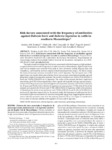Use este identificador para citar ou linkar para este item:
http://www.alice.cnptia.embrapa.br/alice/handle/doc/905367Registro completo de metadados
| Campo DC | Valor | Idioma |
|---|---|---|
| dc.contributor.author | TEMBUE, A. M. | pt_BR |
| dc.contributor.author | SILVA, F. J. M. | pt_BR |
| dc.contributor.author | SILVA, J. B. | pt_BR |
| dc.contributor.author | SANTOS, T. M. | pt_BR |
| dc.contributor.author | SANTOS, H. A. | pt_BR |
| dc.contributor.author | SOARES, C. O. | pt_BR |
| dc.contributor.author | FONSECA, A. H. | pt_BR |
| dc.date.accessioned | 2011-11-09T11:11:11Z | pt_BR |
| dc.date.accessioned | 2011-11-09T11:11:11Z | pt_BR |
| dc.date.available | 2011-11-09T11:11:11Z | pt_BR |
| dc.date.created | 2011-11-09 | pt_BR |
| dc.date.issued | 2011 | pt_BR |
| dc.identifier.citation | Pesquisa Veterinária Brasileira, v. 31, n.8, p.663-666, Ago. 2011 | pt_BR |
| dc.identifier.uri | http://www.alice.cnptia.embrapa.br/alice/handle/doc/905367 | pt_BR |
| dc.description | The study aimed to evaluate the risk factors associated with the frequency of IgG antibodies against Babesia bovis and B. bigemina in cattle in southern Mozambique. Eight hundred and nine serum samples were collected from cattle in three provinces namely Maputo, Gaza and Inhambane, and tested by indirect enzyme-linked immunosorbent assay (i-ELISA) to assess the humoral immune response towards B. bovis and B. bigemina. The chi-square test at 5% significance was used to determine whether there was an association between gender, age and geographic origin of seropositive animals. The overall prevalence was 78.8% (548/695) for B. bovis and 76.0% (528/695) for B. bigemina. The origin of the animals showed a significant association (p<0.05) with seropositivity to both agents, while gender and age was not associated (p>0.05). Maputo province had the highest rate of positive animals, with 93.7% (118/126) for B. bovis and 97.6% (123/126) for B. bigemina. In Gaza province 77.3% (321/415) of the animals were positive for B. bovis and 67.5% (280/415) for B. bigemina, while in the province of Inhambane the levels of seropositivity were 70.8% (109/154) and 81.2% (125/154) for B. bovis and B. bigemina respectively. In the present study, the frequency of cattle positive for B. bovis and B. bigemina was shown to increase among older age groups, suggesting that infection and re-infection persisted even after the primary infection. Thus, this region is considered to be in a state of enzootic stability with regards to B. bovis and B. bigemina. | pt_BR |
| dc.language.iso | eng | eng |
| dc.rights | openAccess | eng |
| dc.subject | Moçambique | pt_BR |
| dc.title | Risk factors associated with the frequency of antibodies against Babesia bovis and Babesia bigemina in cattle in southern Mozambique. | pt_BR |
| dc.type | Artigo de periódico | pt_BR |
| dc.date.updated | 2011-11-09T11:11:11Z | pt_BR |
| dc.subject.thesagro | Babesia Bigemina | pt_BR |
| dc.subject.thesagro | Babesia Bovis | pt_BR |
| dc.subject.thesagro | Bovino | pt_BR |
| dc.subject.thesagro | Epidemiologia | pt_BR |
| dc.subject.thesagro | Sanidade Animal | pt_BR |
| riaa.ainfo.id | 905367 | pt_BR |
| riaa.ainfo.lastupdate | 2011-11-09 | pt_BR |
| dc.contributor.institution | António A.M. Tembue, Laboratório Central de Veterinária (LCV), Direcção de Ciências Animais (DCA), Instituto de Investigação Agrária de Moçambique (IIAM; Fábio J.M. Silva, (UFRRJ); Jenevaldo B. Silva, UFRRJ; Tiago M. Santos, UFRRJ; Huarrisson A. Santos, UFRRJ; CLEBER OLIVEIRA SOARES, CNPGC; Adivaldo H. Fonseca, UFRRJ. | pt_BR |
| Aparece nas coleções: | Artigo em periódico indexado (CNPGC)  | |
Arquivos associados a este item:
| Arquivo | Descrição | Tamanho | Formato | |
|---|---|---|---|---|
| pesqvetbrascleber.pdf | 154.35 kB | Adobe PDF |  Visualizar/Abrir |









